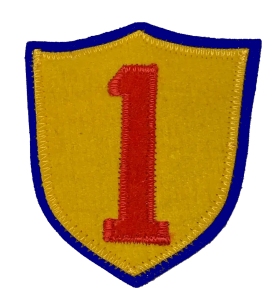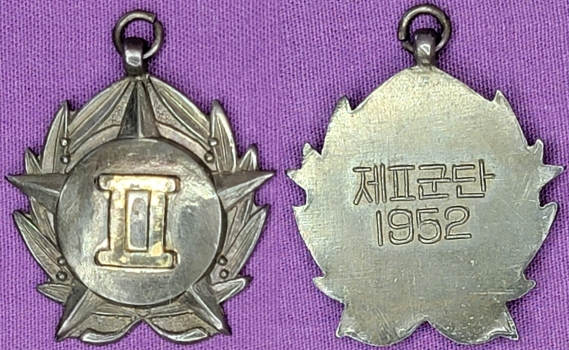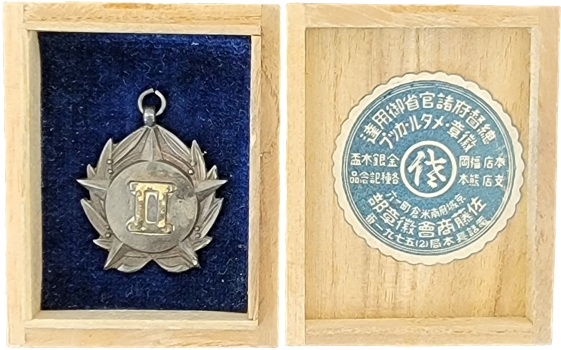1st Infantry Division Commemorative

제 1 사단창설 “Establishment of the 1st Division”
4주년기념 “4th Anniversary”
4284.12.1 “Dec. 1, 1951”

The 1st Infantry Division 제1보병사단 (第一步兵師團) is a military formation of the Republic of Korea Army’s I Corps. The division was established on Dec. 1, 1947 in Seoul, commanded by Colonel Kim Suk-won 김석원 (金錫源 1893-1978).
The 1st Infantry Division was the first ROK Army unit to be attacked by the North Koreans when the Korean War broke out on June 25, 1950. At the time, it was commanded by Colonel Paik Sun-yup 백선엽 (白善燁 1920-2020). The division, as a part of the Korean II Corps, became part of the defensive line to slow the North Korean advance from Seoul to Taejon. While many of the Korean units, broke and ran, the 1st Division withdrew while maintaining its order of battle while fighting this delaying action. This led to Paik being promoted to Brigadier General on July 25, 1950. Keep in mind that most of the Korean military units were ill-prepared and ill-equipped, not to mention that they lacked adequate leadership. The division subsequently fought in the Battle of Pusan Perimeter 부산 교두보 전투 (Aug. 4 – Sep. 18, 1950), fighting at the Naktong River (Aug. 3 – 13, 1950), the capture of Pyongyang (Oct. 19 – 20, 1950), the operation to re-recapture Seoul and the Imjin River (Feb. 7 – Apr. 30, 1951), the campaign of Tongil-Chun (May 10 – May 30, 1951), Operation Doo Mai-ri (Dec. 28, 1951 – Jan. 8, 1952), and Anti-guerilla Operations in the Honam Area; (July 13 – Aug. 6, 1952). After the armistice, the division held front-line positions along the DMZ, under the U.S. I Corps.1
2nd Corps Badge — 1952


In the Center in stylized Chinese characer 佐 from 佐藤 (Sato). It is difficult to determine if the box is original to the badge, because it is not a fitted lodgement.
The II Corps 제이군단 (第二軍團) is nicknamed “Double Dragons” 쌍용부대.
During the early days of the Korean War, Lieutenant General Walton Walker of the US Army ordered that ROK Army units, scattered, demoralized and nearly destroyed by the North Korean invasion, be organized into two corps to defend the Pusan Perimeter. The 2nd Corps was established on July 15, 1950, and first activated on July 24, 1950. It was deployed in the Battle of the Naktong River Defense Line 낙동강 방어선 전투 and destroyed the enemy in the Battle of Dabu-dong 다부동 전투 and at the Battle of Yeongcheon 영천 전투. These battles provided a decisive opportunity for a counteroffensive. Afterward, while the 2nd Corps was advancing from Deokcheon 덕천에서 in North Korea, it suffered heavy losses from the large-scale attack of the Chinese army. By November 4, 1950, the Korean II Corps and the 8th Regiment of the US 1st Cavalry Division were destroyed. The 2nd Corps was temporarily disbanded in Hwacheon on January 10, 1951. What was left was used to carry out an operation to subdue the communists guerrillas in the southern areas of the peninsula as the ‘White Night Warfare Command’ 백야전사령부 (established Nov. 11, 1951, disbanded April 4, 1952, commanded by General Paik Sun-yup 백선엽 (白善燁)). On April 5, 1952, the 2nd Corps was re-established. This badge is probably from that time. The current emblem of the 2nd Corps does not have a star or leaves in the background.
Paik Sun-yup 백선엽 (白善燁 1920-2020)
Both of the badges above can be connected to General Paik Sun-yup 백선엽 (白善燁)

Paik Sun-yup grew up in a poor farming village near Pyongyang. When he was seven years old, his father deserted the family, leaving his mother and his three siblings destitute. Paik Sun-yup, eventually graduated from the Japanese Military Academy 봉천군관학교 in Manchuria, and was commissioned as a second lieutenant. He began his military career at Gamoksa in Heilongjiang Province, China. Baek Seon-yup served as a lieutenant in the “Military Police” 헌병 in the Gando Special Forces established by the Japanese Empire in Manchukuo to suppress the Korean Volunteer Army that was fighting against Japan for the independence of Chosŏn. (Because of his past, his burial, in a National Cemetery, was a very controversial subject.) When Japan was defeated on August 15, 1945, Paik Sun-yup ended his five years of military service in Manchuria and crossed the Tuman River and arrived in Seoul on December 29, 1945. Afterward, he entered the Republic of Korea military. He graduated from the U.S. military English school and became a founding member of the South Korean military. At that time, the Republic of Korea had not been officially launched. After serving as company commander and battalion commander of the 5th Regiment in Pusan, Paik Sun-yup moved to Seoul and became the Director of the Intelligence Bureau. The Yeosu Rebellion was an incident in which the South Korean Labor Party, took control of government offices in Yeosu and Suncheon, joined forces with left-wing soldiers and brutally murdered right-wing figures. Paik Sun-yup’s first task was a large-scale purge of the military in response to the Yeosu Rebellion. If the South Korean military had not filtered out the leftists, it would never have survived Kim Il-sung’s 6/25 invasion of the South.
In February 1949, Park Chung-hee, who later became the President of South Korea, was sentenced to death by a military tribunal on charges of being a military plotter of the South Korean Workers’ Party. He was scheduled to be executed 10 days later. Park Chung-hee actually had little history of working as a military officer of the South Korean Labor Party. Paik Sun-yup reported this to his superiors and received permission to vacate the death sentence. When Park Chung-hee was released from prison, he bowed to Paik Sun-yup and said, “Thank you.” Park Chung-hee received a dishonorable discharge from the military.
Paik Sun-yup contributed greatly to the establishment of the Republic of Korea Army and participated in the Korean War. He started out as a front-line commander of the 1st division of the ROK Army and later served as commander of the 1st corps, commander of the 2nd corps, field combat commander who oversaw the suppression of North Korean partisans in Jiri Mountain area. Paik Sun-yup was promoted to general (at the age of 33) on January 31, 1953. He was the first Korean military officer to reach the rank of four-star general. (Park Chung-hee was promoted to Brigadier General, at the age of 36 on November 25, 1953.) Paik Sun-yup also participated in the Korean Armistice Negotiations. Furthermore, he twice served as the army chief of staff (1952 and 1957) and eventually as Chairman of the Joint Chiefs of Staff (February 1959 to May 1960).
After retiring from the military, he was appointed ambassador to The Republic of China in July 1960. In July 1961, he served as the ambassador to France, the Netherlands, Belgium, Spain, Portugal, and Luxembourg. On July 16, 1961, while serving as ambassador to France, he traveled to Senegal as a representative of the Korea-Senegalese Friendship Mission. In 1961, he served as ambassador to Gabon, Togo, Senegal, Chad, The Congo, Madagascar, Central African Republic, Niger, Ivory Coast, Benin, Republic of Congo, Upper Volta and Mauritania. He also served as the ambassador to Cameroon. Paik served as the first Korean Ambassador to Canada. Later, he served as Minister of Transportation (1969-1971) during the Park Chung-hee administration.
Today, General Paik Sun-yup is the referred to as the Father of the Republic of Korea’s National Defense Forces who saved the country in the Korean War, and President Park Chung-hee is the Father who achieved national revival and modernization of the country.
The U.S. military evaluated Paik Sun-yup as ‘the most outstanding field commander’ or ‘the most trustworthy Korean commander.’ The United States recognized Paik Sun-yup as the best partner of the U.S. military and awarded him several medals.
Paik Sun-yup’s awards
Korea Awards
Order of Military Merit, Taeguk Medal with Gold Star (x4)
Order of Military Merit, Ulchi Medal (x4)
Order of Military Merit, Chungmu Medal (2x)
Order of Military Merit, Hwarang Medal
Order of Industrial Service Merit, Gold Tower Medal
Order of Industrial Service Merit, Tin Tower
Order of Diplomatic Service Merit, Grand Gwanghwa Medal (x2)
Korean War Service Medal
Korean Military Medal of Honor
United States Awards
Silver Star Service Medal
Bronze Star Service Medal
Air Service Medal
Legion of Merit (Degree of Chief Commander)
Legion of Merit (Degree of Commander)
Legion of Merit (Degree of Officer)
Legion of Merit (Degree of Legionnaire)
Department of Defense Medal for Distinguished Public Service
Meritorious Public Service Medal
Other Foreign Awards
Order of Merit (Canada)
Ordre national de la Légion d’honneur (France)
Ordre national du Mérite (France)
Croix de guerre des Théâtres d’opérations Extérieures (France)
Order of Leopold (Belgium)
Order of the Cloud and Banner (Republic of China)
Order of Brilliant Star (Republic of China)
Philippine Legion of Honor (The Philippines)
Order of the White Elephant (Thailand)
Order of the Star of Ethiopia (Ethiopia)
National Order of Upper Volta
Order of the Phoenix (Greece)
Order of George I (Greece)
Distinguished Service Medal of the Republic of Cuba
Order of Merit (Niger)
